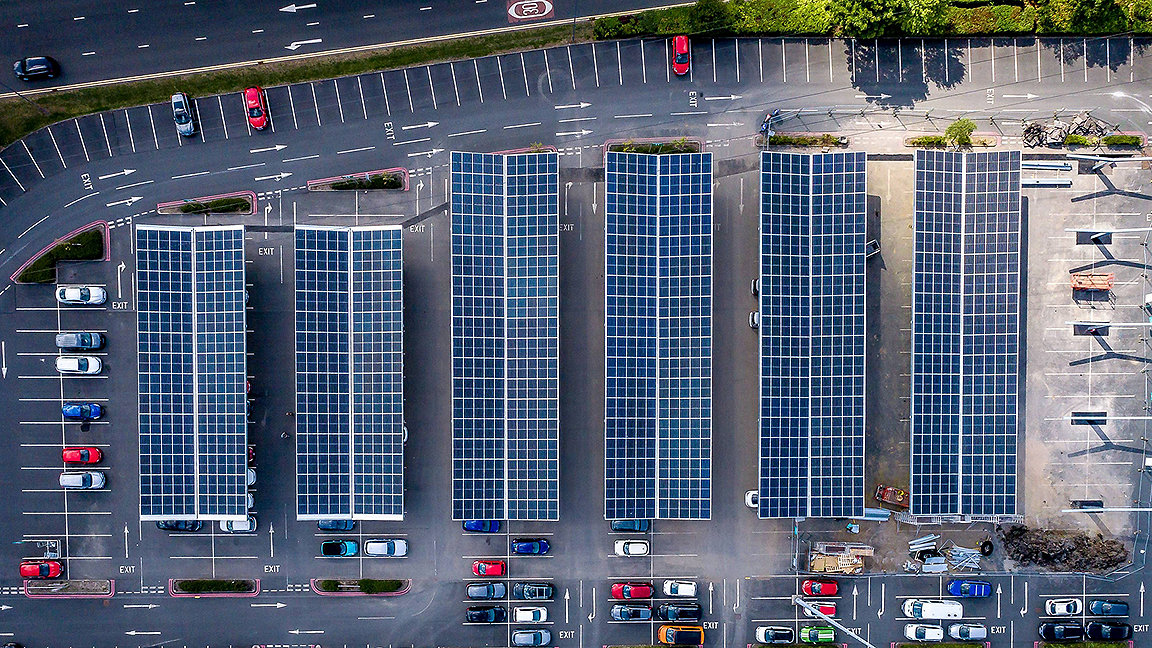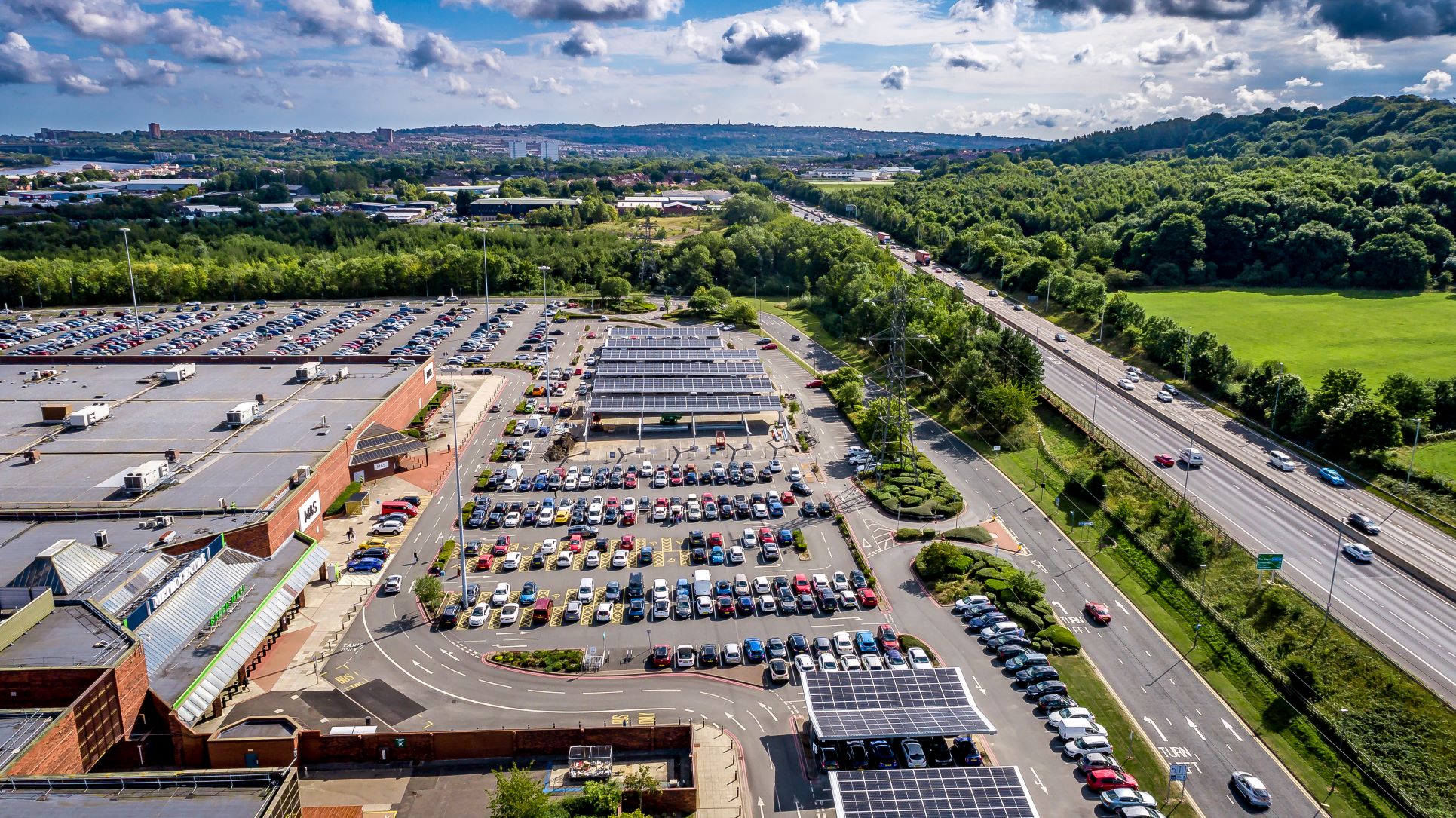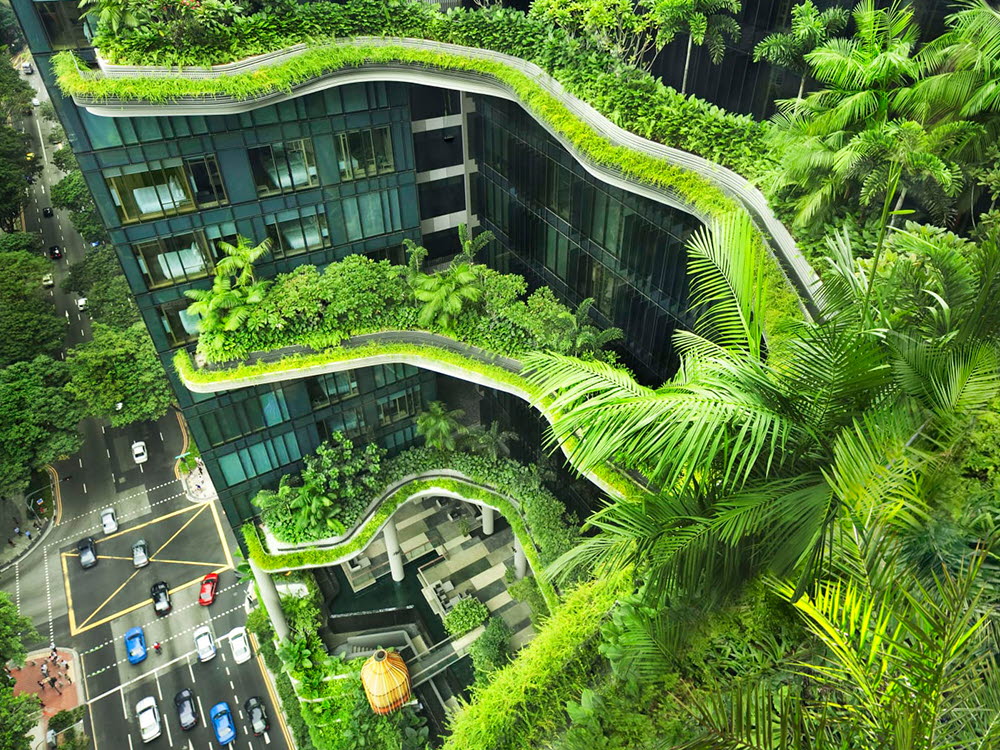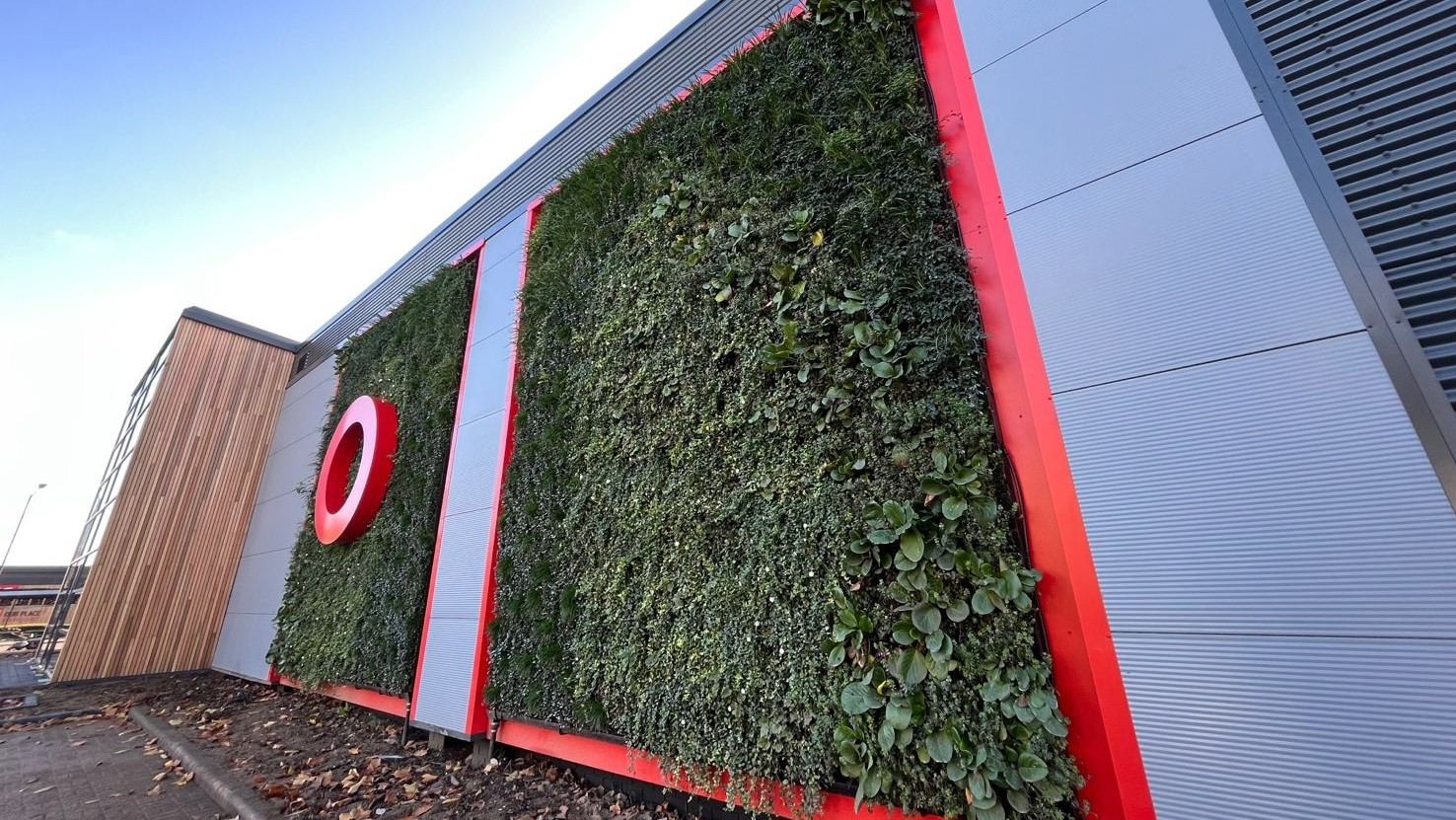
Solar carports at the Metrocentre shopping centre © Syzygy
The Metrocentre is the UK's original 'mega mall'. Located in Gateshead, 6.5km from Newcastle city centre, the Metrocentre has been operating for more than 30 years and remains Europe's largest indoor mall and leisure centre, covering more than 186,000m2.
The centre's integrated solar and electric vehicle charging project originated when renewable energy consultancy Syzygy began working with the mall's owners to decarbonise their portfolio of retail sector assets. From their initial list of properties, the Metrocentre was quickly identified as one of the sites with the most potential to reduce operational carbon significantly.
Modelling demand and scoping on-site supply
It was essential to assess the most appropriate means for incorporating low-carbon energy into the building. This included modelling energy use in the mall to establish the highest daytime energy demand and overlaying the potential for solar energy generation to identify the most appropriate connection points across the site.
Syzygy also made use of its evlab software to establish the requirements for electric vehicle (EV) charge points at the site, ensuring that the centre would be well provisioned as this market continues to grow.
Having examined energy use in the common parts that are operated by the landlord, Syzygy's design team surveyed the building's roof and concluded that the areas useable for solar generation were relatively limited in comparison to the centre's energy needs.
Given that the centre has been substantially developed, with the addition of further retail space and new facilities since it opened in the 1980s, this work required extensive surveys.
The surveys found that the loading capacities of large parts of the roof were insufficient for the extent of solar photovoltaic (PV) panel installation necessary to make a significant impact on the site's energy use and, therefore, operational carbon. They also identified the presence of existing plant and other obstructions, and leases restricting the use of other roof areas.
Therefore, it was concluded that installing solar carports, in addition to solar panels installed on the useable roof areas, would make the greatest impact in reducing the building's carbon emissions. The proposed scheme would also provide a clear statement of the centre's green credentials with carports located above parking bays in the public car park next to one of the main anchor stores, easily viewed from the A1 motorway. Other carports would be incorporated as part of a new public EV-charging hub also within the existing surface car park.
Beyond the additional costs of the supporting steel structures, a carport scheme generally also requires more extensive electrical connections. It would also be imperative that as much of the car park as possible was kept operational while safely managing construction at a busy shopping centre. In comparison, it is simpler and less costly to carry out a solar installation on a roof, out of the way of the public and the centre's daily operations.
These additional complexities made it hard to establish an acceptable economic case for the project and it was put on hold until an opportunity arose to apply for EU funding.
Funding innovation and mitigating procurement risk
In 2018, the project team decided to apply for money for the project through the European Regional Development Fund (ERDF), which aims to improve economic, social and territorial cohesion in underdeveloped regions by investing in innovation, businesses, job creation and community regeneration. If the application was successful, the funding scheme would provide up to 50% of the project's costs which the centre owners would match.
There was a particular focus from the ERDF on the promotion of a low-carbon economy in the North East of England and the Metrocentre scheme offered the opportunity to substantially reduce the environmental impact of a major public site that attracts 21m visitors each year.
The scheme would also provide a highly visible demonstration of how to use existing urban infrastructure to support low-carbon energy generation and transport. At the time of application, this single project would increase the solar capacity in Gateshead Council's local area by 17%.
Having successfully secured funding, the project received final sign-off from the centre owners in spring 2019 and moved to planning application, to be followed by tender and construction.
At the tender stage, the careful specification of equipment was vital to ensure that the solar plant will last for its forecast 25-year design life. Given the public-facing nature of the carports, it was essential that their design was in keeping with Metrocentre's standing as one of the UK's best-known retail destinations.
It was also crucial that procurement strategies were carefully considered, given the general uncertainties in the construction sector – and in the solar market in particular – at the point of contracting. The main solar components were secured as early as possible to avoid delays and inflationary risk.

Solar panels at the Metrocentre shopping centre © Syzygy
Global and local issues stall progress
The project has nevertheless faced several major challenges. There were concerns that EU funding could be at risk due to Brexit; however, after a period of uncertainty, it was established that any funding secured prior to Brexit would be honoured. Then, in spring 2020, just as construction contracts were due to be awarded, Metrocentre's owners went into administration. There was a complete change of ownership team and the project was put on hold for nearly 12 months.
Fortunately, in spite of the lengthy delay and change in ownership, the EU funding remained in place, and having validated and re-established the business case with the new board of directors, in early 2021 the new owners made the decision to resume the project.
Added to Brexit and the change of ownership, the impact of the COVID-19 pandemic and, more recently, the war in Ukraine on global supply chains and commodity prices affected the project's programme and budget.
Furthermore, shortly after the construction contract had been agreed in late 2021, a new development masterplan was agreed for the Metrocentre, which influenced the location of some of the carports and caused further delays while the design was adjusted to suit.
During construction, it has been essential to communicate effectively and coordinate work with the store management team to ensure that the impact on the site's day-to-day operations has been kept to a minimum.
In particular, the needs of anchor stores with entrances directly adjacent to the car park had to be considered. The lease terms for these stores guarantee a certain number of available parking spaces in such areas at any time. The carports are located next to some of the main bus routes into the centre, so careful traffic management has been key.
Project set to cut carbon and charge EVs
The project is now nearing completion (solar installations are expected to be generating in February 2023) and once finished will comprise 3,575 solar panels in two installations. Panels covering around 3,000m2 on the building's roof will have a capacity of 600kW, while there will be a further 1MW on around 5,000m2 across carports in two of the main centre car parks.
In addition, 46 EV charging bays have been installed in a dedicated hub beneath some of the carports. Together, the EV charging bays and solar panels above each parking bay will enable the centre to provide emissions-free fuel for 11,635km of EV power each year.
We have estimated that the electricity generated from the solar panels will reduce annual carbon dioxide emissions by 315 tonnes, equivalent to planting 32,500 trees over the system's 25-year lifetime. Switching to solar energy will also reduce Metrocentre's dependency on the grid by 30%, offsetting more than 37% of its total annual electricity use with its own low-carbon supply.
Given the current disruption to energy markets, the investment in low-carbon energy has given the centre the opportunity to make operational savings by protecting a good proportion of its annual energy supply from the effects of inflation and the exceptionally high energy prices currently being experienced.
The team is also exploring further commercial opportunities, such as making use of the carports for advertising. Northumbria University's Faculty of Engineering and Environment recently visited the site with a view to using it as a case study for students on its master's degrees in renewable energy and electrical power engineering courses.
This is just one of the many ways the solar scheme has enabled the Metrocentre team to demonstrate publicly its commitment to green initiatives.
As the RICS sustainability report 2022 highlights, limiting carbon in the built environment is fundamental to any effective climate policy.
The recent work carried out to reduce Metrocentre's operational carbon is an example of such a strategy in action. It illustrates the important role that digital tools and technologies can play in conducting sustainability-related building surveys. However, the project also underlines some of the obstacles that such initiatives face, including the high cost of low-carbon products and materials.
Despite the numerous challenges of decarbonising the built environment, such retrofitting initiatives are not only good for the environment, but can also increase the value of buildings and investment portfolios and reduce operational costs.
'Given the current disruption to energy markets, the investment in low-carbon energy has given the centre the opportunity to make operational savings by protecting a good proportion of its annual energy supply from the effects of inflation'
Kirsty Berry is director of major projects at Syzygy Consulting
Contact Kirsty: Email
Related competencies include: Property management, Sustainability
RICS champions sustainability across professions
With the built environment estimated to be responsible for around 40% of global carbon emissions, RICS is championing sustainable practices across the built and natural environment. We are also empowering professionals to embed sustainability considerations into the way they work and better measure environmental impacts.


